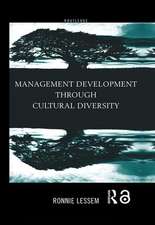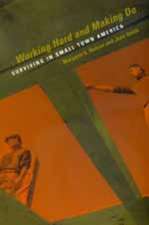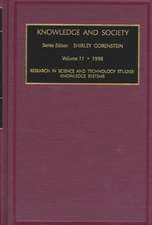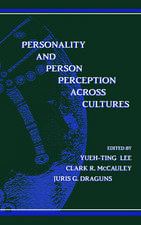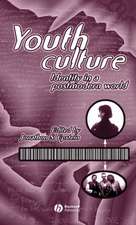Cross-Cultural Analysis: Methods and Applications, Second Edition: European Association of Methodology Series
Editat de Eldad Davidov, Peter Schmidt, Jaak Billiet, Bart Meulemanen Limba Engleză Hardback – 7 feb 2018
Applications from the behavioral and social sciences that use real data-sets demonstrate:
- The use of samples from 17 countries to validate the resistance to change scale across these nations
- How to test the cross-national invariance properties of social trust
- The interplay between social structure, religiosity, values, and social attitudes
- A comparison of anti-immigrant attitudes and patterns of religious orientations across European countries.
This book is intended for researchers, practitioners, and advanced students interested in cross-cultural research. Because the applications span a variety of disciplines, the book will appeal to researchers and students in: psychology, political science, sociology, education, marketing and economics, geography, criminology, psychometrics, epidemiology, and public health, as well as those interested in methodology. It is also appropriate for an advanced methods course in cross-cultural analysis.
| Toate formatele și edițiile | Preț | Express |
|---|---|---|
| Paperback (1) | 510.35 lei 6-8 săpt. | |
| Taylor & Francis – 9 feb 2018 | 510.35 lei 6-8 săpt. | |
| Hardback (1) | 1347.78 lei 6-8 săpt. | |
| Taylor & Francis – 7 feb 2018 | 1347.78 lei 6-8 săpt. |
Preț: 1347.78 lei
Preț vechi: 1643.63 lei
-18% Nou
Puncte Express: 2022
Preț estimativ în valută:
257.89€ • 269.99$ • 213.39£
257.89€ • 269.99$ • 213.39£
Carte tipărită la comandă
Livrare economică 05-19 aprilie
Preluare comenzi: 021 569.72.76
Specificații
ISBN-13: 9781138670648
ISBN-10: 1138670642
Pagini: 684
Ilustrații: 68
Dimensiuni: 152 x 229 x 37 mm
Greutate: 1.05 kg
Ediția:Nouă
Editura: Taylor & Francis
Colecția Routledge
Seria European Association of Methodology Series
Locul publicării:Oxford, United Kingdom
ISBN-10: 1138670642
Pagini: 684
Ilustrații: 68
Dimensiuni: 152 x 229 x 37 mm
Greutate: 1.05 kg
Ediția:Nouă
Editura: Taylor & Francis
Colecția Routledge
Seria European Association of Methodology Series
Locul publicării:Oxford, United Kingdom
Cuprins
Preface Peter Schmidt, Eldad Davidov, Jaak Billiet, and Bart Meuleman Section I: MGCFA and MGSEM Techniques 1. Capturing Bias in Structural Equation Modeling Fons J.R. van de Vijver 2. Evaluating Change in Social and Political Trust in Europe Nick Allum, Sanna Read, and Patrick Sturgis 3. Methodological Issues in Using Structural Equation Models for Testing Differential Item Functioning Jaehoon Lee, Todd D. Little, and Kristopher J. Preacher 4. Estimation and Comparison of Latent Means Across Cultures Holger Steinmetz 5. Biased Latent Variable Mean Comparisons due to Measurement Non-Invariance: A Simulation Study Alain de Beuckelaer and Gilbert Swinnen 6. Testing the Invariance of Values in the Benelux Countries with the European Social Survey: Accounting for Ordinality Eldad Davidov, Georg Datler, Peter Schmidt, and Shalom Schwartz 7. Religious Involvement: Its Relation to Values and Social Attitudes. A Simultaneous Test of Measurement and Structural Models Across European Countries Bart Meuleman and Jaak Billiet 8. Measurement Equivalence of the Dispositional Resistance to Change Scale Shaul Oreg et al. 9. Measurement Equivalence Testing 2.0 William M. van der Veld and Willem E. Saris Section II: Multilevel Analysis 10. Perceived Economic Threat and Anti-Immigration Attitudes: Effects of Immigrant Group Size and Economic Conditions Revisited Bart Meuleman 11. A Multilevel Regression Analysis on Work Ethic Hermann Dülmer 12. Multilevel Structural Equation Modeling for Cross-cultural Research: Exploring Resampling Methods to Overcome Small Sample Size Problems Remco Feskens and Joop Hox 13. Explaining Cross-National Measurement Inequivalence: A Bayesian Multilevel CFA with Random Loadings Bart Meuleman and Elmar Schlüter Section III: Latent Class Analysis (LCA) 14. Testing for Measurement Invariance with Latent Class Analysis Miloš Kankaraš, Guy Moors, and Jeroen K. Vermunt 15. A Multiple Group Latent Class Analysis of Religious Orientations in Europe Pascal Siegers 16. Testing for Invariance of Latent Classes: Group-as-Covariate Approach Maksim Rudnev Section IV: Item Response Theory 17. Using a Differential Item Functioning Approach to Investigate Measurement Invariance Rianne Janssen 18. Using the Mixed Rasch Model in the Comparative Analysis of Attitudes Markus Quandt 19. Random Item Effects Modeling for Cross-National Survey Data Jean-Paul Fox and A. Josine Verhagen Section V: New and Emerging Topics in Cross-Cultural Analysis 20. Exact and Bayesian Approximate Measurement Invariance Daniel Seddig and Heinz Leitgöb 21. Alignment Optimization: Estimation of the Most Trustworthy Means in Cross-Cultural Studies even in the Presence of Noninvariance Jan Cieciuch, Eldad Davidov, and Peter Schmidt 22. Sensitivity Analysis Daniel L. Oberski 23. How Should Immigrants Adapt to Their Country of Residence? A Mixed Methods Approach to Evaluate the International Applicability of a Question from the German General Social Survey (ALLBUS) Michael Braun and Timothy P. Johnson
Notă biografică
Eldad Davidov is Professor of Sociology at the University of Cologne, Germany and the University of Zurich, Switzerland
Peter Schmidt is Professor Emeritus of Methodology of Social Research at the University of Giessen and Humboldt Research Fellow of the Polish Foundation for Basic Research
Jaak Billiet is Professor Emeritus at the Katholieke Universiteit Leuven, Belgium
Bart Meuleman is Associate Professor and head of department at the Centre for Sociological Research (CeSO) at the University of Leuven (Belgium)
Peter Schmidt is Professor Emeritus of Methodology of Social Research at the University of Giessen and Humboldt Research Fellow of the Polish Foundation for Basic Research
Jaak Billiet is Professor Emeritus at the Katholieke Universiteit Leuven, Belgium
Bart Meuleman is Associate Professor and head of department at the Centre for Sociological Research (CeSO) at the University of Leuven (Belgium)
Recenzii
"As was the case with the original volume, this updated volume fills an enormous need in the cross-cultural research literature. It provides a single go-to source of chapters on the methodological and statistical analysis challenges unique to cross-cultural research—or, for that matter, any research project in which group comparisons across levels and time are proposed. Each chapter clearly presents a unique challenge, why it is important, and how it may be addressed. This volume is a valuable contribution not only to cross-cultural researchers but to any researcher examining the similarities and differences between entities (people, groups, teams, organizations, etc.). It can be used as a reference book or as a supplemental textbook in advanced courses on cross-cultural research." – Robert J. Vandenberg, University of Georgia, USA
"This is a must-have book for anyone doing quantitative cross-cultural research in any discipline of social and behavioral sciences. Readers will appreciate book chapters prepared by prominent researchers for their practical and approachable presentations of core methods with examples that address major analytical issues and challenges." - Young Ik Cho, University of Wisconsin-Milwaukee, USA
"This is a must-have book for anyone doing quantitative cross-cultural research in any discipline of social and behavioral sciences. Readers will appreciate book chapters prepared by prominent researchers for their practical and approachable presentations of core methods with examples that address major analytical issues and challenges." - Young Ik Cho, University of Wisconsin-Milwaukee, USA
Descriere
This book presents the latest strategies and methodological developments for the analysis of cross-cultural data. Internationally prominent researchers from a variety of fields explain how the methods work and how to apply them.

















